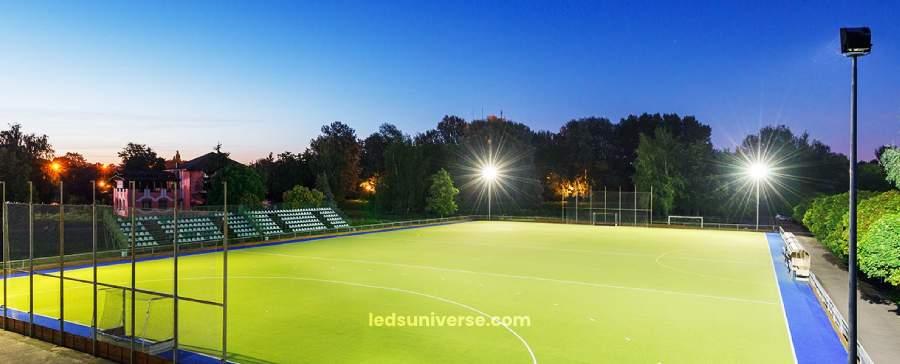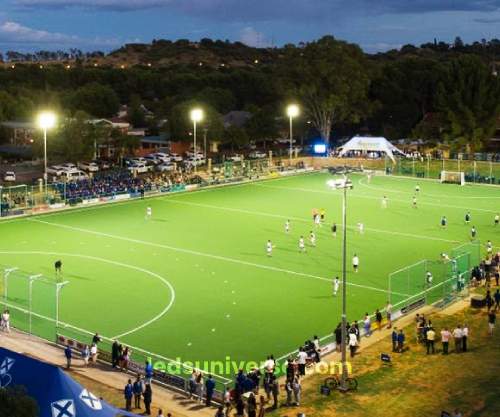In every hockey game, the right lighting transforms the field into a stage for precision, speed, and excitement. Proper illumination not only enhances player performance but also elevates the entire experience for spectators, ensuring every moment is clearly visible and captivating. With advanced lighting solutions, a hockey field becomes more than just a playing surface—it becomes the arena where great moments unfold under the perfect light.
The visibility for players affects the accuracy of their decisions and hence, their performances during the game. For ultimate convenience and utility, each game has its special light requirements. For hockey, high-quality illumination is a necessity because the players are expected to react promptly to a small but fast-paced hockey ball. Every aspect of the game needs proper even illumination and a light color that perfectly matches daylight. More so, every spectator should be able to follow the players’ moves and see everything else around them.
Reach out for free lighting consultation
At LedsUniverse, we are aware of all the special illumination needs of hockey and have developed quality LED hockey lights that meet all the standard requirements mentioned above. Whether it’s ice rink lighting or a hockey field, vibrant lighting enhances the experience for both players and spectators. Properly illuminated hockey fields ensure that even fast-paced actions and movements, such as those of a hockey puck, are clearly visible.
Table of Contents
Toggle| Type of Play | Recommended Lux Level |
|---|---|
| Professional Hockey Games | 500 to 750 lux |
| Training/Recreational Play | 250 to 500 lux |
For hockey fields, ensuring the correct lighting levels is crucial for both safety and performance. Lux levels, which measure the brightness of the lighting, are particularly important. For professional hockey games, a lux level of 500 to 750 lux is typically required. For training or recreational play, lux levels may range between 250 to 500 lux. The higher lux level ensures players can react quickly, make precise movements, and avoid injuries.
In addition to the brightness, uniformity of the lighting is critical. The lighting must be evenly distributed across the field so that there are no dark spots or overly bright areas. Uniform lighting improves gameplay visibility, helping players maintain consistent awareness of the puck, their teammates, and opponents.
Glare control is another essential aspect of hockey field lighting. Uncontrolled glare can impair players’ ability to see the puck or make accurate decisions. Effective lighting systems minimize glare by using anti-glare coatings and optimal fixture placements, allowing players to focus on the game without distractions.

Shadows on the field disrupt players’ ability to judge distances and track the hockey ball accurately, impacting performance. For optimal results, the lighting poles should be strategically placed outside the boundaries of the field to avoid obstructing gameplay. This ensures that poles do not interfere with players’ sightlines, allowing for a clear view of the entire field. Pole placement should also be balanced to create uniform lighting across the field, eliminating dark areas or overly bright spots.
Lighting angles should be carefully considered to avoid direct light shining into the players’ eyes. Excessive direct light can cause discomfort, strain, or even temporary blindness, making it difficult for players to focus. Angling the lights appropriately helps reduce glare and ensures that the entire playing field is well-lit without compromising visibility. The correct lighting angle also enhances the uniformity of the light distribution, improving overall performance and safety for both players and spectators.
Ideally, the height of the poles should range between 12 and 25 meters, depending on the size and requirements of the field. Taller fixtures are more effective in evenly distributing light across the entire playing surface, reducing the chances of shadows or uneven lighting. On the other hand, fixtures that are placed too low may create concentrated areas of light, resulting in shadows and reduced visibility in certain sections of the field. By positioning the lights at the appropriate height, designers can maximize coverage and create a consistently illuminated environment, essential for fast-paced sports like hockey.
With advancements in lighting technology, LED lighting has become the go-to solution for hockey fields. LED lights offer excellent energy efficiency, using up to 70% less energy than traditional lighting systems like metal halide or high-pressure sodium lights. This energy efficiency translates into lower operational costs for field owners while reducing the environmental impact.
Smart lighting systems are also becoming increasingly popular. These systems allow for the adjustment of lighting levels based on usage patterns. For example, during practice sessions, the lighting can be dimmed to save energy, whereas, during games, the lighting can be set to full brightness for optimal performance.

The installation of a hockey field lighting system is a complex process that requires meticulous planning to ensure both performance and safety. One of the most critical aspects of installation is securing the lighting poles properly. Poles must be firmly anchored into the ground, taking into account the soil conditions and local climate. In areas prone to high winds or extreme weather, additional reinforcements such as stronger foundations or guy wires may be required to ensure that the poles remain stable. Proper installation prevents pole shifting or collapse, safeguarding both players and spectators during harsh weather conditions. Additionally, attention must be paid to the electrical wiring, ensuring it is protected from environmental exposure and securely installed to avoid any risk of short circuits or power failures.
Once the lighting system has been installed, regular maintenance is essential to ensure long-term performance and safety. Over time, dirt, dust, and debris can accumulate on the lighting fixtures, reducing their brightness and overall efficiency. Regular cleaning of the fixtures helps maintain optimal light output, preventing the buildup of contaminants that can obstruct light transmission. Furthermore, periodic inspections should be conducted to check for signs of wear and tear. This includes examining the poles, wiring, and fixtures for corrosion, damage from exposure to the elements, or any issues related to structural integrity. Proactively addressing minor repairs or replacing worn components can prevent more significant problems and costly repairs down the line, ensuring the system remains in top condition.
While modern LED lighting systems are known for their durability and energy efficiency, they still require eventual replacement to ensure optimal performance. Newer LED models offer greater energy efficiency, improved brightness, and better control over lighting angles and uniformity. Conducting periodic evaluations of the system allows for timely upgrades that enhance energy savings and reduce maintenance costs in the long term. By staying current with technological advancements, hockey field operators can provide better lighting quality, ensure player safety, and reduce energy consumption, contributing to a more sustainable facility.
In addition to regular maintenance and upgrades, it’s important to have emergency protocols and backup systems in place. Power outages or lighting failures can disrupt games, pose safety risks, and lead to event cancellations. Backup power generators or alternative lighting systems should be installed to ensure that the field remains illuminated even in the event of an unexpected power disruption. Regular testing of these backup systems is critical to ensure they are functioning correctly when needed.
Outdoor hockey field lighting systems need to be built to withstand a variety of weather conditions. IP ratings (Ingress Protection) are used to measure how resistant a fixture is to water and dust. For hockey fields, lighting fixtures should have a minimum IP65 rating, ensuring they are resistant to rain, dust, and other outdoor elements.
Temperature tolerance is another consideration, particularly in colder climates where hockey is often played. The fixtures should be able to function effectively in freezing conditions without compromising light output or energy efficiency. Additionally, wind resistance should be factored in, especially in open fields where strong winds can affect lighting poles and fixtures.
Backup lighting systems ensure that games can continue even in the event of a power outage. In addition, security lighting around the perimeter of the field can enhance the safety of players and spectators during and after the game.
For hockey field lighting, emergency lighting can be installed as part of the system. This ensures that if the primary lighting fails, the emergency lights will provide enough illumination to safely evacuate the area or continue play under certain conditions.
One often overlooked aspect of field lighting is its impact on the surrounding environment. Light pollution control measures are crucial, especially in urban or residential areas. High-quality lighting systems can be designed to minimize light spill, ensuring that light is focused on the field and doesn’t disturb the surrounding areas.
Using eco-friendly materials in lighting fixtures is another way to reduce the environmental footprint of a lighting system. Many modern LED lights are made from recyclable materials, reducing waste when the fixtures reach the end of their lifecycle.
With advancements in technology, particularly in LED lighting, hockey fields can now benefit from energy-efficient, durable, and high-performance lighting systems. From proper lux levels and uniformity to sustainable energy use and minimal maintenance, modern lighting solutions provide the best experience for players and fans alike. Investing in the right lighting design and system ensures that the fast-paced game of hockey is played at its highest level, with excellent visibility and a vibrant atmosphere.
At LedsUniverse, our commitment to providing high-quality LED hockey lights is rooted in our understanding of these specific lighting needs. With vibrant and energy-efficient lighting solutions, we continue to push the boundaries of innovation, making sure that hockey fields around the world are illuminated to the highest standards.